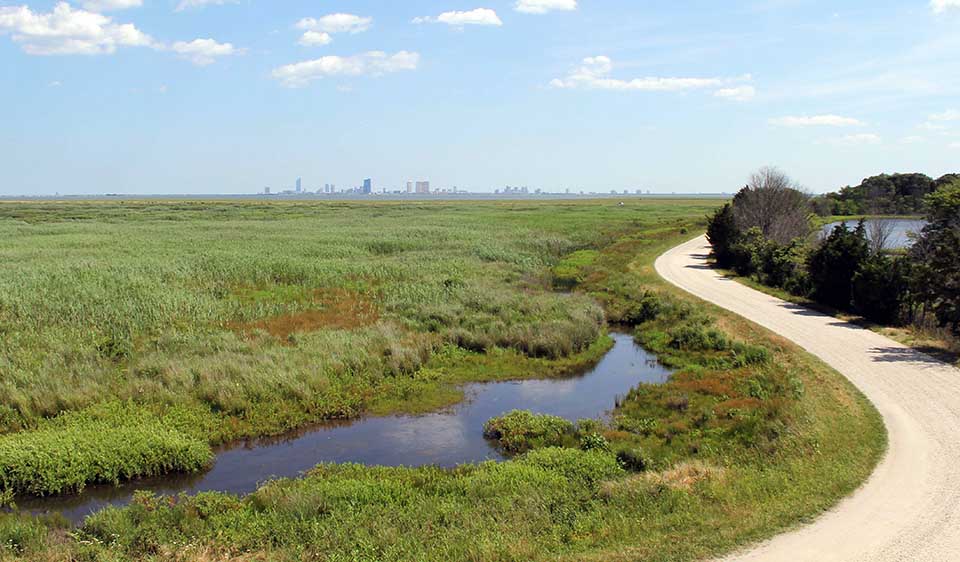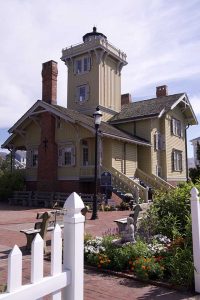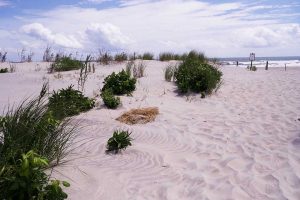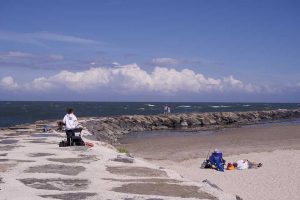Jersey’s Eastern Shore
The off-season is on at the Jersey Shore. Now that the tourists have gone home, it’s our time to explore and enjoy.


Christine is one of my fellow nature comrades. Last week, she and I took to New Jersey’s east coast to check out prospective wild places that you might like to explore now that the summer crowds are thinning out. We will share with you a mixture of favorites and other locations worthy of a visit. Our narrative journey will begin on the mainland in Oceanville (Galloway Township) and travel south to Cape May, beginning and ending with two of the state’s premier wildlife sites: Edwin B. Forsythe National Wildlife Refuge and Cape May Point State Park.
The off-season at the Jersey shore boasts some of the best weather and nature exploration that the state has to offer. Fall is a great time to enjoy resident wildlife or watch migrations heading to southern climes. Our suggested ventures can give you days of active or passive recreational opportunities. Each narrative is only a snippet of what is available at each site. These are intended to whet your appetite, so pack your binoculars, a nature book or two, maybe some bug repellent, don a few layers, and head to our sandy coast.
Edwin B. Forsythe National Wildlife Refuge, at 47,000 acres, is by far the largest of these locations. The Refuge stretches from Brick Township for 50 miles to just north of Atlantic City. By far the most popular place to access the refuge is 800 Great Creek Road in Galloway Township. There you will find a small visitor center giving you an introduction to the refuge and orienting you to a number of trails and the famous Wildlife Drive. Forsythe is best known for its year-round birding opportunities—both forest and wetland species—resident birds as well as migrating avian species. There are two very small trails near the center—the Akers Woodland and the Leeds Eco-Trails. The Bristow and Jen’s Birding Trails intertwine, offering about 3.5 miles of hiking or shorter loop options.

The Friends of Forsythe NWR have recently put together a nice audio tour that you can listen to as you drive the eight-mile Wildlife Drive; access it on Soundcloud.com. This internationally known loop is great for observing birds in all seasons, especially in spring and fall. The wintering waterfowl populations are something to quack about as well. You’ll want to get a bird’s-eye view from the two wildlife observation towers. Remember your camera; wildlife photo ops abound along the drive.
Let’s move out to our barrier islands for a stop in Brigantine at the Marine Mammal Stranding Center. Although visitors can’t visit the mammalian rehabilitees, there is a small museum and gift shop where interns offer wonderful interpretations of the marine models that festoon the dome-like ceiling. Since 1978 the center has been rescuing and rehabilitating sick and injured marine mammals and sea turtles. Recovered animals are returned to the wild. It is the only federally authorized animal hospital in the state and the efforts put forth there are remarkable. As of August 11, strandings for 2022 that the staff has addressed include 36 dolphins, 50 seals, 19 turtles, and three whales. Visiting the museum, gift shopping, or making a donation goes toward their mission of helping marine mammals in need.
Looking to add something quirky to your nature checklist? Just nine miles south of the Stranding Center you’ll find New Jersey’s most famous pachyderm—Lucy the Elephant. Right now she is literally under wraps as she is being renovated and getting a new paint job. This is my teaser for a late fall/early winter visit when her renovation is unveiled. Stay tuned; I’m a sucker for whimsical destinations.
A few weeks ago our article covered the Ocean City Welcome Center where we enjoyed viewing the heron rookery about eight road miles south of Lucy. So we’ll leapfrog to the southern tip of Ocean City’s barrier island and its 341-acre jewel—Corson’s Inlet State Park. Here you can spend the day on the beach, oceanside or on the bay, without beach tags (however, no swimming is allowed). You can cast a fishing line from either area. Also New Jersey residents can launch a boat for $12 a day, or $60 for the season (and after Labor Day launching is free). There is car and boat trailer parking, and two valued portable potties. On August 16 the protected oceanside areas that had been roped off for endangered piping plovers and other beach nesting birds were reopened.
At Corson’s, Christine and I opted to take the yellow trail walk over the dune system, about 0.7 miles out and back. This allowed us to transition from bayfront to oceanfront through the forested ecotone dune. Scissor-grinder cicadas were advertising for mates and their raspy drone ruled the soundscape. On this short stretch of snow fence-lined trail we were amazed by the diversity of vegetation. We noted horse nettle, evening primrose, bayberry, red cedars, prickly pear, yarrow, black cherry, blackberries, beach plum, rough cocklebur—and yes, lots of poison ivy. On the beachfront edge of the dune there were patches of sea rocket.

The stiff off-ocean wind caused especially rough waves but kindly kept the bugs at bay. The drought has left vernal pools dry but there are plenty of wetland acres on the site, so, as with most of our Jersey Shore locations, carrying bug repellent is advised.
The barrier island towns of Strathmere and Sea Isle City, at their southern tip, are separated from the next island south, home to Avalon and Stone Harbor, by Townsend’s Inlet. At 94th Street and Landis Avenue is the Townsend’s Inlet Waterfront Park. It allows access to the interface between the ocean and bay beaches. The Park offers parking, a shade pavilion, a couple of picnic tables, surf fishing, and a short walking path that leads to the Inlet’s beach. Here, too, there are the much-treasured portaloos.
Crossing the Townsend’s Inlet bridge, your visit lands you at the northern end of Avalon and the 8th Street jetty. A portion of the jetty’s rocky crevices is filled with concrete, allowing for walking the section that juts into the Atlantic. If the surf is rough this is ill-advised.
New Jersey Audubon has a seabird watch between 8th and 9th streets. Because the north end of Avalon famously projects out about one mile further than the barrier islands to the north, southbound seabirds following the coast pass closer to this beach point. New Jersey Audubon explains the avian passage as such: “The migration of seabirds along the coast of New Jersey is spectacular, and an average of almost 800,000 seabirds are counted at the Avalon Seawatch annually. In some years the count approaches one million birds.”
The height of activity is from October 7 to November 14, but groups of birds can pass through at any time.
The Wetlands Institute is located about six miles south of the Seawatch, at 1075 Stone Harbor Boulevard in Stone Harbor. It has been conducting research for 50 years, in part to further enlighten the public. The best known of their activities is terrapin sea turtle protection. They host educational programs that make a stop well worth it. Check out their aquarium display, documentaries, and gift shop. The bulk of their youth programming is in the summer, but The Institute is open weekends in fall and winter.
Our next spot heading south is about six miles past the Institute—Hereford Inlet Lighthouse. The 1874 lighthouse is on the National Parks Service’s list—National Register of Historic Places—and was designed by Paul J. Pelz who went on to plan out the U.S. Library of Congress. The exhibits have some interesting relics and give insight into the treacherous waters of Hereford.
The lighthouse’s beautiful gardens have been featured in Coastal Living magazine and recognized by the Pennsylvania Horticultural Society. They have also been declared Certified Wildlife Habitat by the National Wildlife Federation and provide the four basics—food, water, cover, and places to raise young. They are eye candy to be sure—but I would challenge them to incorporate more native species.
We will resume our southward itinerary next week with the Two Mile Beach Unit at the Cape May National Wildlife Refuge. Our leapfrogging down the coast is surely not a single-day endeavor but is intended to give context to your adventures, which should be savored on many trips—and even return trips. For many of us, these outdoor adventures are a lifelong enjoyment. n
For any of the suggested locations, check websites for fall and winter hours. You may wish to call in advance to verify.









